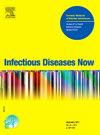Beta-lactam underdosing is not more frequent in COVID-19 than in non-COVID-19 critically ill patients
IF 2.2
4区 医学
Q2 INFECTIOUS DISEASES
引用次数: 0
Abstract
Objectives
COVID-19 has been associated with high rates of ventilator-associated pneumonia relapse. Antibiotic underdosing due to augmented renal clearance (ARC) has been suggested as a possible contributing factor. This retrospective study compared plasmatic beta-lactam concentrations between critically-ill COVID-19 and non-COVID-19 patients.
Patients and methods
We included measurements for cefotaxime, ceftazidime, cefepime and piperacillin. A multivariable logistic regression model was used to identify variables associated with underdosing.
Results
All in all, 361 samples were included from 126 patients. Median concentrations did not differ between COVID-19 and non-COVID-19 patients for any molecule, nor did the rate of underdosing (38 % vs 42 %, p = 0.68). In a logistic regression model adjusting for age, gender, BMI, creatinine clearance and type of beta-lactam molecule, COVID-19 status was not associated with underdosing (OR = 0.83 [0.38–1.83], p = 0.997).
Conclusions
Although underdosing of most commonly prescribed beta-lactams occurred in more than one third of cases in critically-ill COVID-19 patients, this rate did not differ from non-COVID-19 patients.
COVID-19中β -内酰胺剂量不足的情况并不比非COVID-19危重症患者更频繁。
目的:COVID-19与呼吸机相关性肺炎复发率高相关。由于肾脏清除率增强导致的抗生素剂量不足被认为是一个可能的因素。这项回顾性研究比较了COVID-19危重患者和非COVID-19患者血浆β -内酰胺浓度。患者和方法:我们纳入了头孢噻肟、头孢他啶、头孢吡肟和哌拉西林的测定。使用多变量逻辑回归模型来识别与剂量不足相关的变量。结果:126例患者共纳入361份样本。在COVID-19和非COVID-19患者中,任何分子的中位浓度没有差异,剂量不足率也没有差异(38 % vs 42 %,p = 0.68)。在调整年龄、性别、BMI、肌酐清除率和β -内酰胺分子类型的logistic回归模型中,COVID-19状态与剂量不足无关(OR = 0.83 [0.38-1.83],p = 0.997)。结论:尽管超过三分之一的COVID-19危重患者出现了最常用的β -内酰胺类药物剂量不足的情况,但这一比例与非COVID-19患者没有差异。
本文章由计算机程序翻译,如有差异,请以英文原文为准。
求助全文
约1分钟内获得全文
求助全文
来源期刊

Infectious diseases now
Medicine-Infectious Diseases
CiteScore
7.10
自引率
2.90%
发文量
116
审稿时长
40 days
 求助内容:
求助内容: 应助结果提醒方式:
应助结果提醒方式:


